Book Review: Stitch Step by Step by Maggi Gordon and Ellie Vance
It was a moment of serendipity when I spotted this book, Stitch Step by Step by Maggi Gordon and Ellie Vance, on the “new additions” shelf at the library back in September – I didn’t know it but I was about to get poorly sick — not ill enough to just collapse in a heap but not well enough to, you know, move. I suddenly found myself with a lot of sewing playtime!
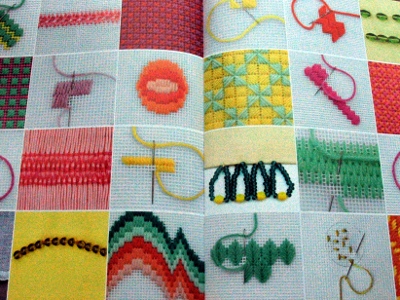
The design of the book grabbed me from the outset: the pretty blue/dotty cover; the clear, well laid out tutorial pages; and the stitch galleries, oh my, the stitch galleries.
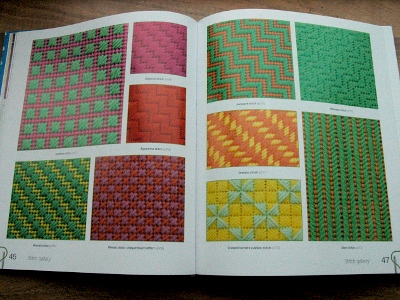
I think it’s worth noting that I’m quite new to embroidery. I’ve cross-stitched for a few years now but I’ve not spent a lot of time looking into the different stitches available when you break away from the cross (or fractions of it) and backstitches. The stitch galleries in this book really opened my eyes to the different possibilities – I could suddenly see the appeal of making samplers! As this is nearly all counted-thread work, it didn’t seem a million miles from my cross-stitching and it gave me the confident to jump straight into some stitching myself.
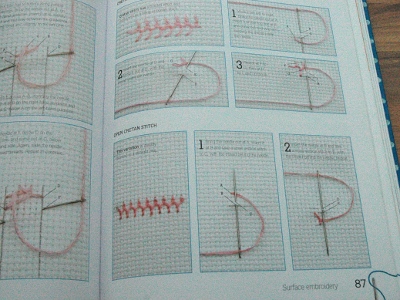
I’ll admit, I followed a handful of the tutorials because it was clear to see what to do from the stitch gallery pictures but those that I did follow were clear step-by-step guides as the title of the book suggests :) The pictures were crisp, with good fabric/thread contrast so it was easy to see what was going on. (The one I “chose” to take bad pictures of to illustrate this point is probably the least contrasting one but you can see the layout.)
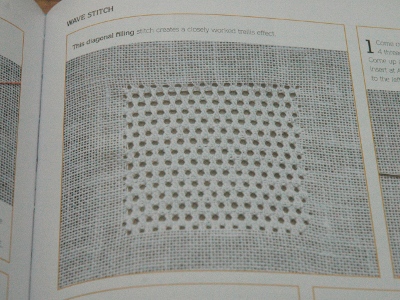
In addition to the colourful thread work, there were also sections on whitework – which was a new concept to me (the idea of using the stitches to open up holes in the fabric I mean, not just the white-on-white stitching), using beads & sequins and on designing as well as stitching Florentine/Bargello work. Purr. Me like!

As with all tutorial books, they covered the basics as well – how to use embroidery hoops, useful tools, finishing and whatnot – which again, was useful for a newbie like me.
Overall, I didn’t read this book cover-to-cover or feel like I wanted to try every different stitch/tutorial – but it’s not for that: it’s for providing inspiration and reference, and I think it does those things very well.
I did have two minor problems with it though – both design issues. Firstly, I had the hardback version from the library. Apparently there is a paperback version available too — I think the hardback would be better than that but better still would have been a ring-bound hardback, that could have sat open of its own accord on my knee while I was stitching.
The second problem I had was a minor – but very annoying – thing: each page number was decorated with a cute image of a needle and thread. I would see it out of the corner of my eye and try to brush it away. On every. single. page. Sometimes multiple times on each page. ARRRGGGH!! ;)
All in though, I’m very glad I came across it and next time I’m in a sewing mindset (I’m all about crochet at the moment), I think I might have to add it to my bookshelf at home.
Read MoreYour favourite fiction books with simple living characters/themes?
I’m having a bit of a book week here on The Really Good Life – and on Recycle This too.
Following on from yesterday’s favourite non-fiction simple living books, I thought I’d do a run down of my favourite fiction books with simple living themes – either characters who live simple lives, or who grow or make or cook real food — but I can’t think of many. So instead, I’ll tell you the few I like and then I’m going to beg, on my knees beg, for your suggestions!
(I asked this question on UK Veg Gardeners nearly a year ago and most people suggested non-fiction-with-a-narrative books that are meant to be read curled up in an armchair in winter rather than a reference text — I do like those too but in this case, I’d prefer out and out fiction suggestions if possible.)
Ok, so here are my few:
- Drop City by TC Boyle – this one certainly won’t be for everyone as it’s half about hippies, with their free love & LSD, but the other half is about life in the Alaskan bush and it’s fascinating. I now have a collection of non-fiction books about life in Alaska to read whenever I finish Drop City because I don’t want to leave that world.
- Giants in the Earth by Ole Edvart Rolvaag – I was hesitant to include this one because I didn’t love-love-love it but it was very interesting – the experiences of some Norwegian settlers “going West” in the 1870s and their subsequent hard life as homesteaders. Apparently it’s core reading on many high school or college syllabuses in the US but it’s pretty much unheard of in the UK.
- Various post-apocalyptic speculative fiction – my guilty genre fiction pleasure — you can keep your vampires and your spaceships, I like reading about our world coming to an end ;) It might seem odd to include it on this but when humanity is all but destroyed and there is no one to delivery take-out pizza or make new ipods, people quickly fall back to simple-style living. Even if the books don’t go into lots of explicit detail about it, it’s there – and I think it’s the bit that really fascinates me, and gets my cogs working in a “what if I was in that situation?” way. The Day of the Triffids by John Wyndham is one of my favourite books full stop and for this sort of thing – slowly rebuilding a farm for the group’s survival, and also a lot of discussion about how society should be rebuilt. The third part of Wyndham’s The Kraken Wakes deals with global warming-like flooding. John Christopher’s The Death of Grass is mostly about a journey but one happening because of the … death of grass (so no wheat etc or grazing land for animals) – it makes me want to run out and grow potatoes!
…And that’s it, that’s all I can muster — so please, please, please have you got any suggestions I can add to my to-read pile? This winter might be another long, cold one so I need plenty of fireside entertainment :)
Read MoreMy ten favourite simple living/growing/cooking/making books
(Inspired by book-aholic buying behaviour this month, I’ve decided to have a bit of a book-themed week both here and on my recycling site, Recycle This.)
Despite living on the internet & using it/blogs for most of my day-to-day info, I’ve got quite a few simple living related books and as you might expect, some are better than others. Some were chosen after careful research, others randomly picks from charity shops & the like – but as is often the case, there is little correlation between that and which are the better books!
Here, in no particular order, are some of my favourites:
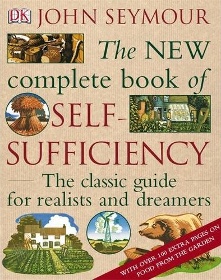
- The New Complete Book of Self-Sufficiency by John Seymour – this is a great overview book of so many different things. It’s admittedly more aspiration than practical for me at the moment – and because it covers so many different areas, it doesn’t feel like the most practical book anyway (it doesn’t have space to go into detailed how-tos/trouble-shooting on each different topic) but it’s still very useful. If I was fleeing to escape the zombie hordes*, this is probably the non-fiction book I’d grab.
Growing

- The Vegetable & Herb Expert by DG Hessayon – my first veg growing book and the one I keep going back to over & over again. Not hugely detailed on each type & some bizarre comments about only eating chillis if they’re part of “your heritage”, but very clear, with lots of pictures (very useful when troubleshooting pests/diseases) and packed with useful info.
- Grow Your Own Vegetables by Joy Larkcom – this book is almost the opposite of the Hessayon – lots of detail but not anywhere near as easy to dip into and few illustrations. I like them together but would struggle with the Larkcom on its own.
- The Edible Container Garden: Fresh Food from Tiny Spaces by Michael Guerra – I was a little disappointed when I got this as it includes a lot of whitespace, big pretty rather than purposeful pictures and a lot of general overview text — but the 30 pages on “what shall I grow?” made the book worth it – very useful reference information about varieties, pot depths etc. I would recommend it to anyone who grows more than just the basic herbs in containers – but try to find a secondhand one so you don’t resent paying for the padding.
Charity shopping haul: books! books! books! and yarn
I seem to go through splurging fazes – spending a lot of money in one particular spending category each month. Last month it was clothes, the month before it was crafts and the month before that was eating-out/take-out food. This month, it’s looking like it’ll be books.
As I’ve said before, I love books but have bought surprisingly few for me this year – and I think that’s what inspired me to buy eight books in the first eight days of October! I think, for the sake of our bookshelves & my purse, I shouldn’t keep up that rate all month!
Two were new & full price (a rarity for me), two were second-hand from Amazon and the other four were charity shop finds from Saturday. We had the good fortune of going to the charity shops in Shipley just a couple of days after someone with similar reading tastes to us had a clearout – the shelves were full of interesting non-fiction books, half of which we had and the other half spiked our interest.
I got:

“Waste” by Tristam Stuart, a book about innovative (but often long standing) solutions to food waste, a little guide to woodworking with some easy project how-tos (I have a big encyclopedia on the same topic but this looks more immediately practical) and for fun, since I’ve been reading a lot of factual stuff lately, “World War Z” by Max Brooks which was amusing filed in the non-fiction section (it’s presented as a non-fiction oral history but is about the Zombie War, which, you know, hasn’t happen [yet]. I spent yesterday afternoon reading it and so far, would definitely recommend it to post-apocalyptica fiction fans). The books are all in really good condition but the charity’s “please give this back when you’re done” stickers were really annoyingly sticky and I’ve dented the front of “Waste” and “World War Z” by trying to peel them off. Grr.
At another shop, I picked up a little book about growing fruit:
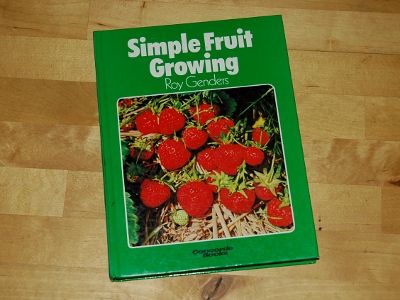
I have a couple of dedicated books about vegetables but none about fruit, just the odd reference in more general books. This one isn’t the most comprehensive encyclopedia ever but has already answered a couple of questions I had about soft fruit bushes, so I think it’ll be well worth 50p.
I also made two craft purchases while I was out:

1000g of navy Guernsey, 100% wool yarn for £5. Not sure what I’ll use it for yet but it’s such a novelty to find enough wool for an entire project in a charity shop – and at such a bargain price too. According to the British Breeds website, their 5-ply usually retails at £5.50 per 100g ball!
I also took a chance on a squished-but-otherwise-brand-new “funky cord kit” – essentially two foam circles and some cotton threads designed for making friendship bracelets and the like.
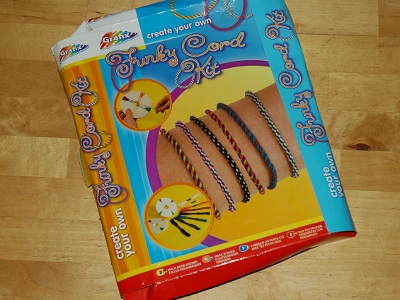
It’s a kids’ kit but I’m a big kid who like playing about with thread so I’ll have fun trying it for 20p :)
Have you been charity/thrift/op shopping recently? If so, any good finds?
Read MoreA few quick links to elsewhere
Having a busy (and rainy) day today so no time for a proper post but just time for some links that might interest you a little self-promotion ;)
- After the brief discussion about composting teabags the other week, I did a bit of research about which brands/types contain synthetic fibres (polypropylene) and posted the results on Recycle This. In brief, stapled gusset ones are polypropylene-free but you might have to remove the staple/string. All the rest are heat-sealed and contain polypropylene – the teabags should break down and the synthetic fibres “disappear” into your compost, but it’s up to you whether you want it in there.
- I’ve very much enjoyed Rachel‘s recent tours of her village and garden, and planned to do my own of the awesome woods behind our house (and maybe beyond). But I forgot to take my camera when we’ve gone on long walks around the woods recently and since Lily sprained a leg last week, our recent walks have been shorter. On Friday, we just walked the “lower loop” as we call it, through the horses’ field. I did take pictures of that though so stage 1 of my tour: John & Lily in the horses’ field.
- And those who enjoyed the book pictures a few weeks ago may like my Venn Diagrams of my favourite books.




